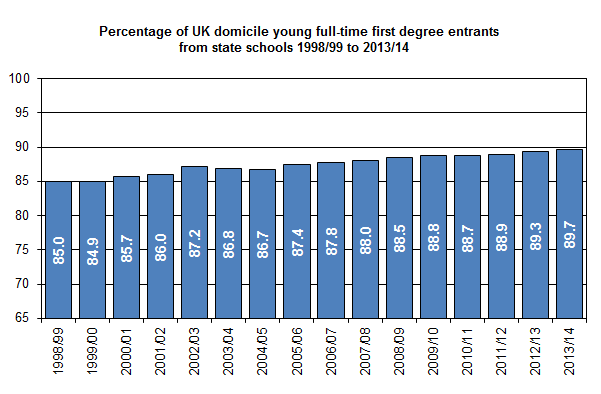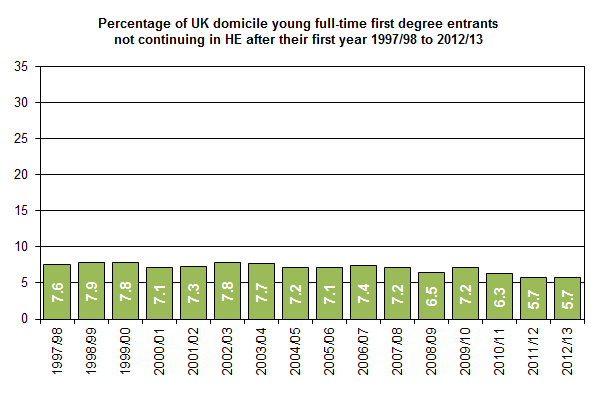UK Performance Indicators in higher education 2013/14
Indicators for Widening Participation and Non-continuation are published today on our website.
The full tables show the indicators for every publicly funded HE provider in the UK alongside their benchmark.
Table T1a shows the percentage of young entrants in 2013/14 from state schools, lower socio-economic classifications (SEC) and low participation neighbourhoods by HE provider.
Table T3a shows the percentage of 2012/13 entrants not continuing into second year by HE provider.
Table T5 shows the projected outcomes for 2012/13 entrants by HE provider.
Summary tables showing statistics for the whole UK can be found here.
Widening participation of under-represented groups
The latest statistics show that of all UK domiciled, young, full-time, first degree entrants in 2013/14:
- 89.7% were from state schools - the highest proportion since the indicators were introduced
- 32.6% were from NS-SEC classes 4-7 - also the highest level recorded
- 10.9% were from low-participation neighbourhoods (see Note 5 below).
The graph below shows the proportion of UK domiciled, young, full-time, first degree entrants from state schools for the years 1998/99 to 2013/14 (see Note 6 below):

More Widening Participation summary tables and charts can be found here. The full HE provider level tables are available here.
Non-continuation rates
The latest statistics show that 5.7% of UK domiciled, young, full-time, first degree entrants in 2012/13 did not continue in higher education in 2013/14. This equals last year's figure for 2011/12 entrants, which was the lowest non-continuation rate since the indicators were introduced. The graph below shows the non-continuation rates of UK domiciled, young, full-time, first degree entrants from the years 1997/98 to 2012/13:

More Non-continuation summary tables and charts can be found here. The full HE provider level tables are available here.
Notes for Editors
- Press enquiries should be directed to:
- Simon Kemp
- HESA Press Officer
- 01242 211120
- [email protected].
- Technical enquiries should be directed to:
- HESA PI team
- 01242 211115
- [email protected].
- The Guide to UKPIs explains what the UK Performance Indicators are, and why they are produced.
- The UKPI tables include a Benchmark for each HE provider. This is a sector average adjusted for the type of HE provider in question. The benchmarks are not government targets or quotas. See the Guide to UKPIs for more information, or the Benchmarks page for full technical details.
- Low Participation Neighbourhoods are defined by the POLAR3 classification created by HEFCE. This is an update of the previous POLAR2 classification and so the figures for this indicator are not perfectly comparable with years before 2009/10.
- The state school indicator is not adjusted to reflect changes in the relative proportions of state and independent school pupils over time.
- The UK Performance Indicators are defined and specified by the UK Performance Indicators Steering Group (UKPISG). Questions about UKPISG should be addressed to the HEFCE Press Office on 0117 9317363.
- A second tranche of UK Performance Indicators covering Employment of Graduates will be published in July 2015.
Ends

Press Officer
